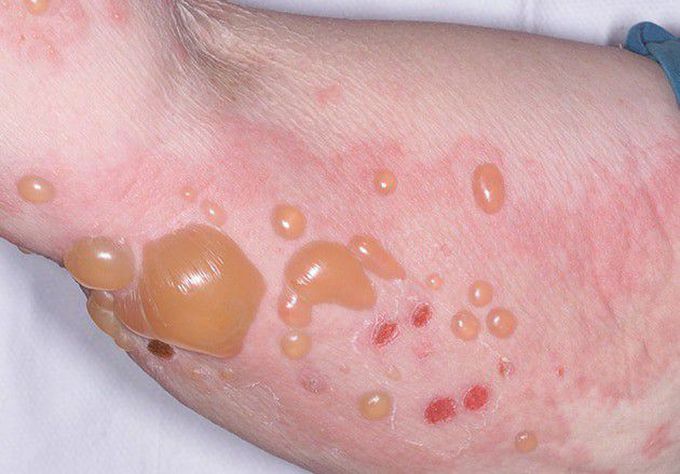


BULLOUS PEMPHIGOID
Bullous pemphigoid is a rare skin condition that typically affects people in middle age and beyond. It causes a range of skin findings, from itchy, hive-like welts to large, fluid-filled blisters which can get infected. Bullous pemphigoid may affect a small area of the body or be widespread. The blisters usually occur on areas of the skin that are flexible, such as under the armpit or on the abdomen. About one-third of people with bullous pemphigoid develop blisters in their mouth, throat, and esophagus, in addition to their skin. Symptoms of bullous pemphigoid come and go. In most patients, the condition goes away within 5 years. Who gets bullous pemphigoid? Bullous pemphigoid occurs most often in people over age 60, but it can appear in younger individuals as well. It is seen more in the Western world; it is not common in the Far East. Both men and women are affected equally by bullous pemphigoid. What causes bullous pemphigoid? Bullous pemphigoid is an autoimmune disorder. That means it occurs when the body’s own immune system attacks the layer of tissue below the top layer of skin. The reasons for this attack are not known, but bullous pemphigoid can sometimes be triggered by certain medications, including penicillamine. What are the symptoms of bullous pemphigoid? Bullous pemphigoid can present with itching, hive-like welts, and multiple blisters, called bullae. These are most commonly seen on the: Arms. Legs. Abdomen. Groin. Mouth. The blisters may break open and become an open sore or ulcer. The fluid inside the may be clear, or contain some blood. The skin around the blisters can appear either normal or red. The blisters are usually located along creases in the skin. You should seek medical attention from your healthcare provider if you think you might have bullous pemphigoid. How is bullous pemphigoid diagnosed? Your doctor will usually begin an exam to see if you have bullous pemphigoid by asking a series of questions, such as: When did your symptoms begi? Do your blisters have pus or blood? Have you had a fever? Have you started any new medications? Your doctor may then perform tests to confirm the diagnosis. These include blood tests and a skin biopsy. How is bullous pemphigoid treated? Bullous pemphigoid is most commonly treated with corticosteroids. These can be taken by mouth in addition to topically applied creams. Antibiotics or other anti-inflammatory medications may also be useful in mild cases. Severe cases may require the use of immunosuppressant medications. Oral corticosteroids can have serious side effects, so it is important to closely follow your doctor’s instructions. Be sure to alert him or her of any problems while taking the medication. Side effects can include: Weight gain. High blood pressure. Diabetes mellitus. Upset stomach or indigestion. Hip pain. The risk of side effects increases the longer you take corticosteroids. For this reason, your doctor will try to come up with the most efficient treatment plan possible for you. What is the prognosis for bullous pemphigoid? Bullous pemphigoid usually goes away within 5 years, and generally responds well to treatment. However, blisters that rupture and become infected can lead to a life-threatening condition called sepsis. For this reason, it is important to seek treatment at your first sign of symptoms.

